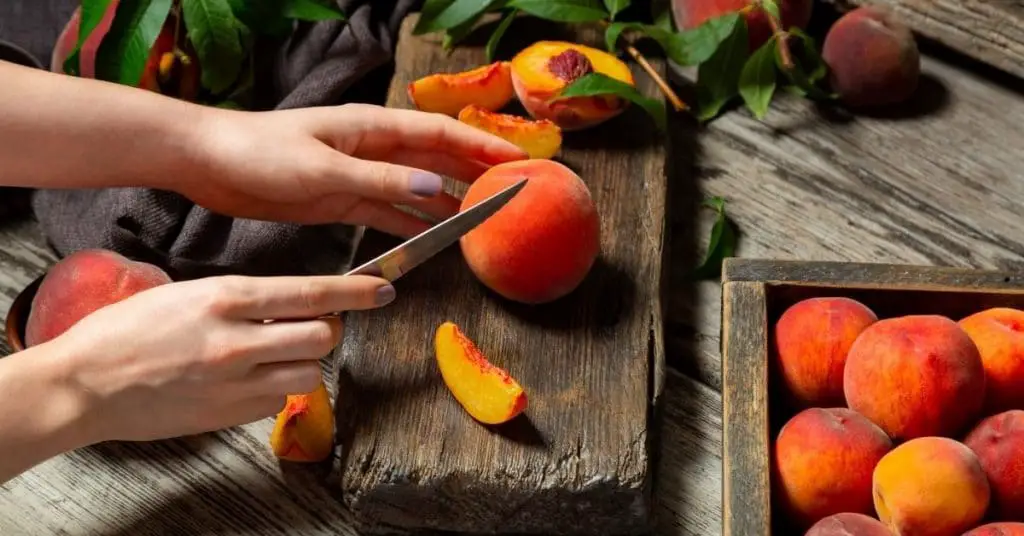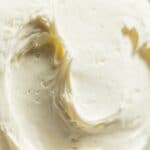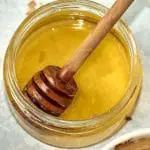In a nutshell: Yes, fresh peaches can be frozen, but they will lose their firm texture once thawed. Preserving peaches in syrup for freezing will result in optimal color and texture preservation. Ensure peaches are fully ripe and without bruises or soft spots before freezing.
Deliciously juicy, fresh peaches are fabulous to use in both sweet and savory applications. They can be eaten raw, dried, or cooked and add loads of fruity flavor to any dish.
Peaches keep well in a cool, dry place, but as with most fruit, they don’t last long once ripe or cut.
Freezing peaches is a great way to preserve them and prevent food waste. By freezing them you can also enjoy the frozen fruit in many ways outside of peach season. There are a few different ways to prepare peaches for freezing to ensure the best preservation of flavor, texture, and color.
The method you use to freeze the peaches may depend on how you wish to use them after thawing. Read on to find out everything you need to know about freezing fresh peaches successfully.
Can Peaches Be Frozen?
Yes, fresh peaches can be frozen although they will lose their firm texture once thawed. Preserving peaches in syrup for freezing will result in optimal color and texture preservation.
If they are going to be transformed into a peach crisp or cobbler, freezing them dry or coated in granular sugar is best. In this case, you could even add spices to your peaches before freezing.
Peaches should be fully ripe, but firm without bruises or soft spots. Do not freeze unripe or overripe peaches. The skin can be left on or removed when freezing. Peaches that have been skinned, cut and dry-packed for freezing have the most versatility.
How To Freeze Peaches
Follow the below steps to learn how to freeze fresh peaches:
Step 1: Clean
Wash and peel peaches if desired. Remove the pit of the peaches.
To remove the skin, dip the whole peaches in a large pot of boiling water for 45 seconds and then immediately place them into an ice bath. The skin should now easily peel off.
To remove the pit, use a knife and slice the peach in half all the way along the peach line. Twist the two peach halves apart until they separate from each other and remove the pit left in the center.
Step 2: Cut
Once cleaned, cut the peaches into quarters, slices, or cubes as preferred for freezing.
Step 3: Prepare and Pack
The best way to freeze peaches will depend on how you plan to use them once thawed. The addition of ascorbic acid or lemon juice prevents peaches from turning brown and is essential for color preservation.
Method 1: Sugar Coat
Mix ¼ teaspoon of ascorbic acid or 1 tablespoon lemon juice per cup of sugar. Mix one cup of sugar with 4 to 5 cups of sliced or cubed peaches. Toss to coat well and let the mixture sit for 10 to 15 minutes almost forming a syrup coating.
Portion the sugar-coated peaches into appropriate amounts for freezing according to the amount you would need to thaw at any given time.
Keep in mind that the peaches will likely clump together when freezing. This means you will have to thaw and use the entire portion when removing it from the freezer.
Pack each portion into a resealable freezer bag and press out as much air as possible before sealing the bag to prevent freezer burn.
Method 2: Sugar Syrup
Another way to preserve peaches is by submerging them in a simple syrup. The result after thawing will be similar to canned fruit. This method is ideal if you are planning to use the peaches uncooked after thawing in a fruit salad for example. We recommend you use peeled peaches.
To create your syrup, dissolve one cup of sugar in 2 cups of lukewarm water in a saucepan. Bring to a boil and stir until all the sugar is dissolved. Add 1/4 teaspoon of ascorbic acid for each cup of syrup. Add the cut peach chunks or slices to the hot syrup for 2 minutes.
Remove the peaches with a slotted spoon, keeping the syrup to the side.. Let it cool completely. Do not pack the peaches or syrup while warm. Portion the peaches into airtight freezer-friendly containers and cover the peaches with the cooled syrup leaving half an inch headspace open at the top.
Place a piece of crumpled parchment paper on top before closing and sealing the lid.
Method 3: Dry Freeze
To prevent browning, toss the peaches in 1/3 cup of sugar mixed with the juice of half a lemon or mix ascorbic acid with a little water and toss to coat the peaches lightly.
Line a baking sheet with wax paper or parchment paper. Spread the peach slices across the lined baking sheet in a single layer.
Place the baking sheet into the freezer just until frozen. Transfer the frozen peach slices from the baking sheet into freezer bags in the desired portions.
The flash-freeze method prevents peaches from clumping together. Remove as much air as possible before sealing each bag.
Step 4: Label and Freeze
Keep track of how long the peaches have been stored by labeling each freezer container or bag with the date before placing it in the freezer.
How To Thaw Frozen Peaches
To defrost, remove the peaches from the freezer and place the container or bag in the fridge.
It is best to put the freezer bag or container onto a plate to catch any water when thawing. Leave overnight to defrost. If frozen in a sugar syrup, stir the mixture occasionally.
You can use frozen peaches in smoothies without thawing or eat them as an icy sweet and fruity snack.
Types of Peaches
Peaches have a velvety orange-yellow thin outer skin. The yellow or whitish juicy fruit flesh surrounds a large center pit or stone. Peaches are firm and juicy, although they can bruise very easily causing unpleasant brown spots.
The variety with smooth skin is called nectarines, and these have a brighter red and yellow glossy outer skin. Peaches with white flesh are generally sweet, while other yellow varieties have a slight acidic hint combined with its juicy sweetness.
Freestone and clingstone are the two main classifications of peaches. The name refers to how much the fruity flesh clings to the large center pit.
For the purpose of freezing only, it is more convenient to use freestone peaches as you will have less trouble and effort required to clean and prepare the peaches for freezing.
Peaches are popular in fruit salads, green salads, used in tarts, puddings, cheese platters, as dried fruit, peach compotes, chutney, juices, pastry fillings, and even in a sorbet. If not eaten raw, they can be cooked, canned, turned into peach jam, or dried.
FAQs
Conclusion
Peaches are such versatile fruits that it is worth preserving every last one. Make sure you freeze your peaches before they become too ripe, and use them for months to come, even after the harvesting season is over.
Enjoy them in breakfast, lunch, dinner, and dessert dishes. Finally, there is a way to enjoy these delicious summer fruits all year long.
Up next: can you freeze pears?
*image by beton_studio/depositphotos









